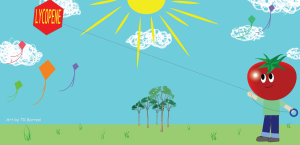DISCLAIMER: I am not medically trained in any sense of the definition, and this article should be considered only as one person’s perspective based on personal experience and lots of Google searches… This is NOT intended to replace recommended and practical precautions against sun damage, merely to provide supplemental information.
Your first response upon reading the title of this article might have been along the lines of “what the hell do tomatoes have to do with kite flying“, I’m trying to take more of a “lifestyle” angle in the interest of providing varied and useful content for fliers who spend inordinate amounts of time in the sun throughout the year – and as a flier myself, I’ve always tried to be conscious of the sun’s harmful effects but I’m also somewhat concerned about sunscreen ingredients (such as oxybenzone, benzophenone, octocrylene, or octyl methoxycinnamate) that may be potentially carcinogenic or have other health risks… That’s not a debate I want to get into however, the express purpose of this article is to provide a little personal experience that I’ve found to be useful in my daily life as a kite flier.
Several years ago, I noticed something interesting… Time and time again, I seemed to have a higher resistance to sunburn after eating sizable quantities of cooked tomato products, as well as a quicker healing period after the fact if I consumed cooked tomato after sustaining a sunburn – this happened with a great deal of consistency, so I did a little research and learned something about lycopene, beta carotene and other antioxidants in relation to our ability to deal with the more volatile rays of the sun.
When certain kinds of skin cells are overexposed to UVA and/or UVB sunlight, they experience metabolic stress, including one called oxidative stress. This stress can overload our antioxidant nutrient supplies, and it is one reason I’ve started to focus on antioxidant-rich foods that can reduce risk of sunburn.
Lycopene is a natural compound that belongs to a class of compounds called carotenes. Carotenes are plant pigments that share certain elements of chemical structure and usually have color somewhere in the orange-red-brown range. To one degree or another, different carotenes can scavenge free radicals and block visible and UV-light.
Some interesting articles on tomatoes, Lycopene, etc:
- http://beta.abc.go.com/…/Sunburn-Relief-Daphne-Oz
- http://news.menshealth.com/3-sunburn-fighting-foods/2012/08/19/
- http://health.ktvb.com/article.php?pr=0&ar=530&geo=id
- http://www.livestrong.com/…/what-are-the-health-benefits-of-tomato-paste/
- http://www.sciencenews.org/view/generic/id/1636
The best food source of lycopene is tomatoes. In raw tomatoes however, lycopene is tightly bound to indigestible fiber so eating raw tomatoes provides relatively small amounts of bio-available lycopene whereas cooked tomatoes, such as tomato paste or tomato sauce are a far better dietary source, and you might also consider using a small amount of oil in the meal as lycopene is fat soluble and absorbed more readily when dissolved in oil.
According to some sources, you’d need to eat at least 100 grams (3.5 ounces) of tomato paste a day to get any appreciable health and skin benefit of lycopene, so some folks prefer to use lycopene supplements… My wife and I tend to focus on “bio-available” forms or through actual whole foods that offer a lot of what we’re in need of – a favorite manufacturer of ours for supplements is “NOW“, due to their unwavering product quality at a time when many “off the shelf” supplements are being made with cheap overseas ingredients (seriously – look it up).
[amazon_enhanced asin=”B000JN7URE” container=”” container_class=”” price=”Hide” background_color=”FFFFFF” link_color=”000000″ text_color=”0000FF” /] [amazon_enhanced asin=”B0013P1GD6″ container=”” container_class=”” price=”Hide” background_color=”FFFFFF” link_color=”000000″ text_color=”0000FF” /]
The ability of lycopene to block UV light is an additional benefit for the skin. However, lycopene has SPF of about 3, which is insufficient to protect from direct sun or any other harsh UV exposure. On the other hand, it is enough to reduce the effects of indirect sunlight or the sunlight that has passed through window glass. For people who do not wish to use sunblock at all times, an alternative strategy may be to wear a sunblock (SPF 15 or greater) outdoors, and use a lycopene lotion at other times.
Although my personal experience has been tangibly positive, some reports indicate that dietary intake may not be sufficient to maximize the benefits of lycopene. When ingested, it is distributed throughout the entire body and only relatively small amount finds its way into the skin. However, I’ve also read that lycopene is well absorbed if applied topically (e.g. in a cream or lotion) because it is fat soluble and has relatively small molecules.
Maybe next time I’ll cover the benefits using of tomato sauce to condition your ripstop sails against UV rays but that’s all I have to offer for now – I hope you find some benefit from this article and research, errrr, cook for yourself!
Whether you’re right or left on this subject, bon appetit, a good meal can’t hurt. 🙂
Good winds and clear skies,
John Barresi


